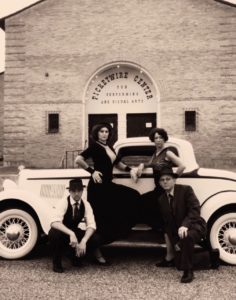Unexpected La Junta Experiences
1. Outdoor Recreation

The Comanche National Grassland is responsible for the management of 443,764 acres of range lands and 300 different species of birds, reptiles, amphibians, & mammals. Not only that but the Comanche National Grassland encompasses a fascinating landscape that reveals the history of the region in its exposed rock layers of prehistoric sea bedsand ancient lake shores rift with dinosaur tracks.
Picketwire Canyon is located just 20 miles from La Junta, and is open for hiking, horseback riding and mountain biking. Picketwire Canyon contains one of the largest dinosaur track beds in the world, ruins of an old Mexican mission and settlement, Native American Rock Art and an early 19th century ranch, now preserved by the Comanche National Grassland.
Vogel Canyon is just a short drive from La Junta; beautiful Vogel Canyon is always a popular destination because it has something for everybody - from a short hike to a quiet picnic. Four hiking trails take you to the canyon bottom and mesa top. The park provides picnic grounds and hiking trails with a variety of difficulty and length.
Guided auto tours are the easiest way to experience Picket Wire Canyonlands and learn about its rich, colorful past. During the tour, knowledgeable guides will show you difficult to find dinosaur tracks, and the interesting prehistoric, historic, and natural features of the canyons. All day tours (8 a.m. to 4 p.m.) are offered on Saturdays in May, Junta, September and October.
2. History

Bent's Old Fort National Historic Site features a reconstructed 1840s adobe fur trading post on the mountain branch of the Santa Fe Trail where traders, trappers, travelers and the Cheyenne and Arapaho tribes came together in peaceful terms for trade. Today, living historians recreate the sights, sounds and smells of the past with guided tours, demonstrations and special events.
Visitors can hike the mile and a half Bent's Old Fort Hiking Trail that winds its way through the cottonwood trees alongside the Arkansas River. The marsh is home to several species of birds. Interpretive exhibit signs tell the story of the river ecosystem, Santa Fe Trail and Bent's Fort.
3. Tarantula Trek and Tarantula Festival

Visit the Comanche National Grassland during the yearly tarantula trek when tarantulas appear en masse in Southeast Colorado during the fall
While this phenomenon has traditionally been called a migration, it is actually an annual mating ritual performed by male tarantulas who roam across the 443,000-plus acres on the Comanche National Grassland looking to mate.
The best time to view tarantulas is an hour before dusk during mid-September thru October and even into early November—depending on the weather. Because these spiders prefer undisturbed lands to nest, the vast and beautiful prairies on the Comanche National Grassland make ideal habitats.
The first time visitor to the Comanche National Grassland is usually surprised to find such a varied landscape from rolling short grass prairies to rugged canyons rimmed by pinion-juniper forests.
4. Santa Fe Trail
Between the years 1821 – 1880, the Santa Fe Trail was America’s first international highway. Celebrating 200 years in 2021, the Santa Fe Trail Bicentennial is a commemoration of a living part of the American Experience. The Trail remains crucial to American history in all its many forms: connecting people in commerce, conflict, and culture.


Picketwire Center for the Performing & Visual Arts, recognized by the State of Colorado as the longest, continuously running community theatre remaining in Colorado that owns its own building, celebrating nearly 60 years of live community theatre in the Arkansas Valley. Picketwire Players performed their first play in 1968, and they have had a show or season of shows every year since that time.
